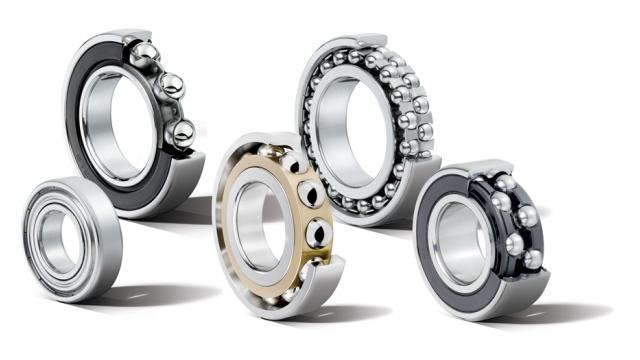
Understanding Torque in Bearings
Torque is the force that produces rotation.
Starting torque is the force required to cause the bearing to start moving. The starting torque of a rolling bearing is defined as the frictional moment that must be overcome by the bearing to start rotating. Starting torque can be considered initially to be breakaway torque as it is the moment when the bearing while stationary is forced into movement.
Running torque is the value of torque required to keep the part rolling at a constant speed once it starts rotating.
For bearings these are the two torque values that need to be considered , calculated and employed for proper operation.
There are many possible factors influencing torque values needed for starting and running torque.
Both SKF and Schaeffler Bearing Company offer engineers an ability to make calculations for determining torque requirements for all bearing types and designs.
Bearing torque is based on the principles of tribology which is the study of friction, lubrication, and wear of interacting surfaces in relative motion. When a bearing rotates, it experiences different types of torque resistance.
- Rolling Resistance
Rolling bearings consist of an inner ring, an outer ring, rolling elements (such as balls or rollers), and a cage to maintain separation between the rolling elements. As the bearing rotates, the rolling elements come in contact with the raceways of the inner and outer rings, causing rolling resistance or rolling friction. This resistance arises due to the deformation and sliding of the rolling elements and the lubricant present in the bearing.
- Seal Friction
Bearings often incorporate seals to prevent the ingress of contaminants and retain lubrication. These seals can introduce additional friction, known as seal friction or drag torque. The amount of seal friction depends on the design, materials, and condition of the seals.
- Lubricant Viscosity
Bearings require lubrication to reduce friction and wear. The lubricant used can be oil or grease, which has a specific viscosity. Viscosity is a measure of a fluid’s resistance to flow. Higher viscosity lubricants create greater resistance to rotation, resulting in higher torque.
- Hysteresis
Hysteresis torque occurs in certain types of bearings, such as magnetic bearings. It arises from the energy dissipation due to the magnetic forces acting on the rotor as it rotates within a magnetic field. Hysteresis torque is highly dependent on the magnetic properties of the materials used.
Calculation of Bearing Torque
Calculate the radial load which is the load perpendicular to the bearing axis.
Calculate the axial load which is the force acting parallel to the shaft’s axis. Once these load calculations are known, factors such as the number and size of rolling elements, the contact angle, and the dimensions of the raceways will be needed. Bearing geometry is a critical factor influencing torque calculations.
Friction coefficients are also needed for bearing torque calculations. They represent the resistance to motion caused by friction between the rolling elements and the raceways. Friction coefficients for specific bearing types and lubrication conditions will be found in manufacturer websites or catalogs.
Formula for calculating bearing torque: Torque (M) = Fr * d * μ + Fa * Dm * μa
Where:
- M represents the torque
- Fr denotes the radial load
- d signifies the rolling element diameter
- μ stands for the rolling element friction coefficient
- Fa represents the axial load
- Dm represents the mean diameter of the bearing
- μa denotes the axial friction coefficient
By understanding the calculated torque, engineers can assess whether a bearing can withstand the anticipated loads, operate within acceptable torque limits, and maintain efficient motion. Proper sizing of bearings will prevent premature wear, excessive heat generation, and potential system failures.
Speed Dependence of Bearing Torque
Understanding the speed dependence of bearing torque is important in selecting bearings for high-speed applications. We will discuss the concept of speed dependence, the factors influencing it, and the importance of considering speed when choosing bearings.
Speed dependence is when bearing torque undergoes changes as rotational speed increases. Several factors contribute to speed dependence, including rolling element skidding, centrifugal forces, and lubrication effects.
Rolling element skidding occurs when the rotational speed of the bearing exceeds a critical threshold. At high speeds, the rolling elements may not fully roll between the raceways but instead exhibit slight sliding or skidding motion. This skidding generates additional friction, resulting in increased torque and heat generation within the bearing.
Centrifugal forces also come into play as rotational speed increases. These forces cause the rolling elements to experience outward displacements, altering the load distribution within the bearing. Consequently, the contact conditions and friction characteristics change, affecting the torque experienced by the bearing.
Lubrication effects further influence speed dependence. At higher speeds, the lubricant’s ability to form and maintain a sufficient film between the rolling elements and raceways becomes crucial. Insufficient lubrication can lead to increased friction, heat generation, and torque.
Conclusion
Understanding what influences bearing torque and calculating bearing torque accurately, will greatly help in bearing selection. It is essential to consult reputable sources and follow manufacturers’ guidelines to obtain accurate torque specifications for specific applications, ensuring optimal performance and system reliability.
Still have a question or need to discuss something? Contact us to get help.


